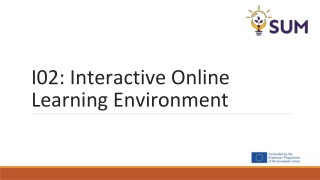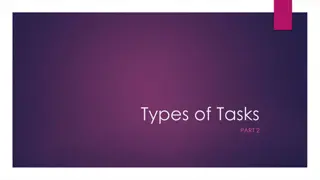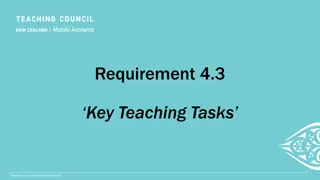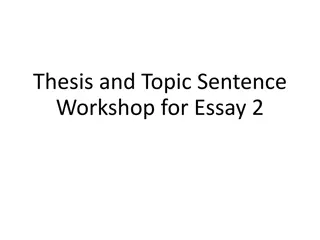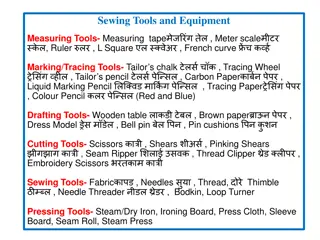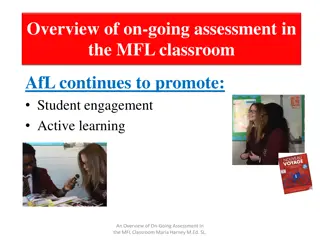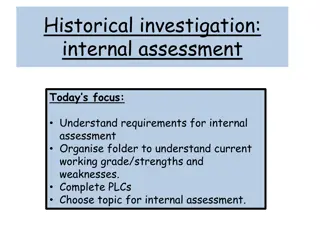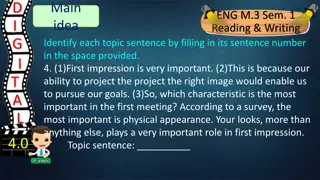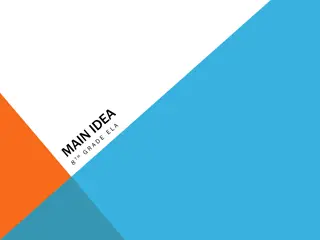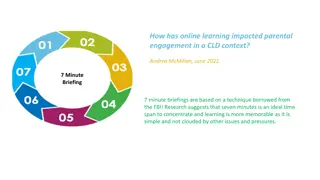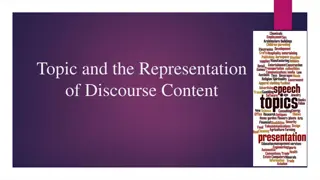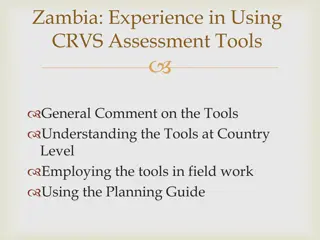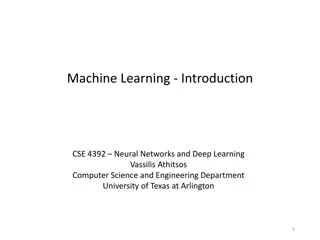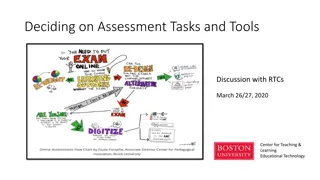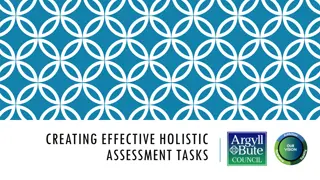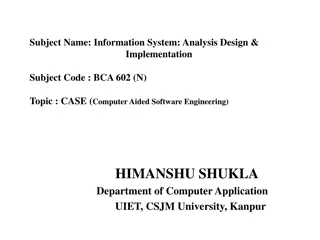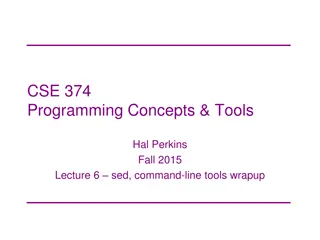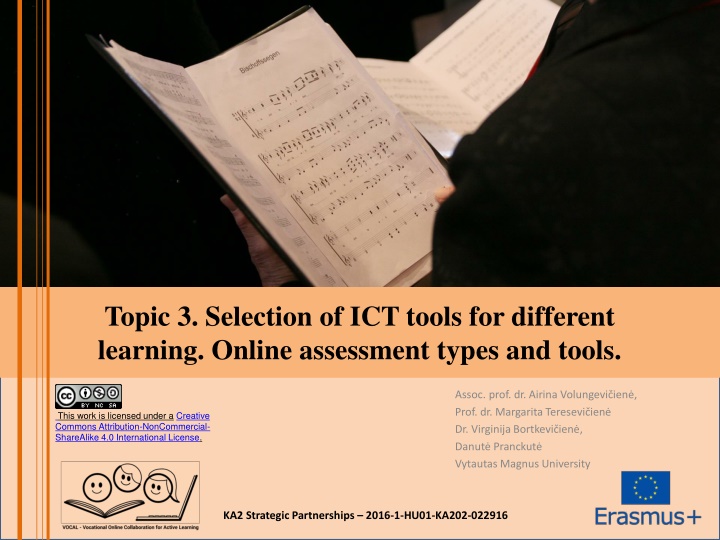
Effective Assessment Methods for Diverse Learning Tasks
Explore the selection of ICT tools for various types of online assessments, under a Creative Commons license. Understand different assessment tasks and methods categorized by learning outcomes. Discover practical examples for critical thinking, problem-solving, and technique demonstration.
Download Presentation

Please find below an Image/Link to download the presentation.
The content on the website is provided AS IS for your information and personal use only. It may not be sold, licensed, or shared on other websites without obtaining consent from the author. If you encounter any issues during the download, it is possible that the publisher has removed the file from their server.
You are allowed to download the files provided on this website for personal or commercial use, subject to the condition that they are used lawfully. All files are the property of their respective owners.
The content on the website is provided AS IS for your information and personal use only. It may not be sold, licensed, or shared on other websites without obtaining consent from the author.
E N D
Presentation Transcript
Topic 3. Selection of ICT tools for different learning. Online assessment types and tools. reative Commons License Assoc. prof. dr. Airina Volungevi ien , Prof. dr. Margarita Teresevi ien Dr. Virginija Bortkevi ien , Danut Pranckut Vytautas Magnus University This work is licensed under a Creative Commons Attribution-NonCommercial- ShareAlike 4.0 International License. KA2 Strategic Partnerships 2016-1-HU01-KA202-022916
TYPES OF ASSESSMENT TASKS 1. 2. 3. 4. 5. 6. Short form and multiple-choice tests; Short answer test; Essay; Performance test; Written report; Fieldwork/practicum tests form and multiple-choice tests; Projects; 8. 9. 10. Posters; 11. Journals; 12. Portfolios; 13. Group work; 14. Participation. Presentations; Case studies; 7. References: Curtin Teaching and Learning. (2010). Developing Appropriate Assessment Tasks. In Teaching and Learning at Curtin 2010. (pp.22-46). Curtin University: Perth KA2 Strategic Partnerships 2016-1-HU01-KA202-022916
SELECTING METHODS OF ASSESSMENT Nightingale et al (1996) provide eight broad categories of learning outcomes which are listed below. Within each category some suitable methods are suggested: 1. Thinking critically and making judgements; 2. Solving problems and developing plans; 3. Performing procedures and demonstrating techniques; 4. Managing and developing oneself; 5. Accessing and managing information; 6. Demonstrating knowledge and understanding; 7. Designing, creating, performing; 8. Communicating. References: https://www.brookes.ac.uk/services/ocsld/resources/methods.html KA2 Strategic Partnerships 2016-1-HU01-KA202-022916
1. Thinking critically and making judgements (Developing arguments, reflecting, evaluating, assessing, judging) Essay; Report; Journal; Present a case for an interest group; Prepare a committee briefing paper for a specific meeting; Book review (or article). References: https://www.brookes.ac.uk/services/ocsld/resources/methods.html KA2 Strategic Partnerships 2016-1-HU01-KA202-022916
2. Solving problems and developing plans (Identifying problems, posing problems, defining problems, analyzing data, reviewing, designing experiments, planning, applying information) Problem scenario; Group Work; Work-based problem; Prepare a committee of enquiry report; Draft a research bid to a realistic brief; Analyze a case; Conference paper. References: https://www.brookes.ac.uk/services/ocsld/resources/methods.html KA2 Strategic Partnerships 2016-1-HU01-KA202-022916
3. Performing procedures and demonstrating techniques (Computation, taking readings, using equipment, following laboratory procedures, following protocols, carrying out instructions) Demonstration; Role Play; Make a video; Produce a poster; Lab report; Prepare an illustrated manual on using the equipment; Observation of real or simulated professional practice. References: https://www.brookes.ac.uk/services/ocsld/resources/methods.html KA2 Strategic Partnerships 2016-1-HU01-KA202-022916
4. Managing and developing oneself (Working co-operatively, working independently, learning independently, being self-directed, managing time, managing tasks, organizing) Journal; Portfolio; Learning Contract; Group work. References: https://www.brookes.ac.uk/services/ocsld/resources/methods.html KA2 Strategic Partnerships 2016-1-HU01-KA202-022916
5. Accessing and managing information (Researching, investigating, interpreting, organizing information, reviewing and paraphrasing information, collecting data, searching and managing information sources, observing and interpreting) Bibliography; Project; Dissertation; Applied task; Applied problem. References: https://www.brookes.ac.uk/services/ocsld/resources/methods.html KA2 Strategic Partnerships 2016-1-HU01-KA202-022916
6. Demonstrating knowledge and understanding (Recalling, describing, reporting, recounting, recognising, identifying, relating & interrelating) Written examination; Oral examination; Essay; Report; Comment on the accuracy of a set of records; Devise an encyclopedia entry; Short answer questions: True/False/ Multiple Choice Questions. References: https://www.brookes.ac.uk/services/ocsld/resources/methods.html KA2 Strategic Partnerships 2016-1-HU01-KA202-022916
7. Designing, creating, performing (Imagining, visualizing, designing, producing, creating, innovating, performing) Portfolio; Performance; Presentation; Hypothetical; Projects. References: https://www.brookes.ac.uk/services/ocsld/resources/methods.html KA2 Strategic Partnerships 2016-1-HU01-KA202-022916
8. Communicating (One and two-way communication; communication within a group, verbal, written and non-verbal communication. Arguing, describing, advocating, interviewing, negotiating, presenting; using specific written forms) Written presentation; Oral presentation; Group work; Discussion/debate/role play; Presentation to camera; Observation of real or simulated practice. References: https://www.brookes.ac.uk/services/ocsld/resources/methods.html KA2 Strategic Partnerships 2016-1-HU01-KA202-022916
DIGITAL ASSESSMENT TOOLS 1. Google Forms: Create forms with hyperlinks, images, and videos. Use them for surveying and quizzes. 2. Plickers: Plickers is a simple app that lets teachers collect real-time formative assessment data without the need for student devices. 3. Poll Everywhere: A real-time polling app that works with mobile, Twitter, or in your web browser. 4. Socrative.com: Afree web-based service that lets you assess students with prepared activities or on-the-fly questions to get immediate insight into understanding. 5. Nearpod: Nearpod works in the browser of any device to let you create or upload a slideshow, to which you then add your own questions. 6. Classflow: Classflow lets you build lessons using cards you create using the content of your choice. References: Lee Watanable-Crockett. 17 Formative Digital Assessment Tools That Help You Know Students. Available at : https://globaldigitalcitizen.org/17-formative-digital-assessment-tools KA2 Strategic Partnerships 2016-1-HU01-KA202-022916
DIGITAL ASSESSMENT TOOLS 7. Formative: Formative lets you create lessons using any Internet-connected device and is optimized for 1:1, BYOD, flipped or blended classrooms. Get results and respond in real time. 8. Classkick: Upload a PDF and add text, drawings, photos, hyperlinks, and audio recordings to create dynamic lesson content. 9. Padlet: Afree website for collecting and sharing text, images, videos, and files. 10. Seesaw: Students show their work with photos, videos, drawings, text, PDFs, and links. You can also import directly from most popular apps. 11. Recap: A free app that lets teachers prompt the students to explain their thinking on a question or topic using video. 12. Kahoot: This is a popular free class quiz game that lets teachers use multiple choice or sequencing questions. References: Lee Watanable-Crockett. 17 Formative Digital Assessment Tools That Help You Know Students. Available at : https://globaldigitalcitizen.org/17-formative-digital-assessment-tools KA2 Strategic Partnerships 2016-1-HU01-KA202-022916
DIGITAL ASSESSMENT TOOLS 13. Quizizz: Another great game and quiz-making application. 14. Quizlet: Lets students learn and improve by studying with flashcards, games and more. 15. Quizalize: This is a new website for playing class quiz games. The teacher inputs their own questions or they can use a pre-made quiz. 16. Triventy: This is a tool for making group surveys and quiz games. Again, the teacher can use their own questions or use ones on the site. 17. SketchParty TV: APictionary-style drawing game, perfect for reinforcing vocabulary and visual communication skills. 18. Badges. References: Lee Watanable-Crockett. 17 Formative Digital Assessment Tools That Help You Know Students. Available at : https://globaldigitalcitizen.org/17-formative-digital-assessment-tools KA2 Strategic Partnerships 2016-1-HU01-KA202-022916
References https://www.waikato.ac.nz/students/student-assessment/types-of- assessment/types-of-assessment-tasks http://dera.ioe.ac.uk/7800/1/AssessmentforLearning.pdf https://www.brookes.ac.uk/services/ocsld/resources/methods.html Lee Watanable-Crockett. Formative Digital Assessment Tools That Help You Know Students. Available at : https://globaldigitalcitizen.org/17- formative-digital-assessment-tools https://emedia.rmit.edu.au/learninglab/content/assessment-tasks : KA2 Strategic Partnerships 2016-1-HU01-KA202-022916
References Broadfoot, P. M., Daugherty, R., Gardner, J., Harlen, W., James, M., & Stobart, G. (2002). Assessment for learning: 10 principles. Cambridge, UK: University of Cambridge School of Education. Curtin Teaching and Learning. (2010). Developing Appropriate Assessment Tasks. In Teaching and Learning at Curtin 2010. (pp.22-46). Curtin University: Perth. KA2 Strategic Partnerships 2016-1-HU01-KA202-022916

